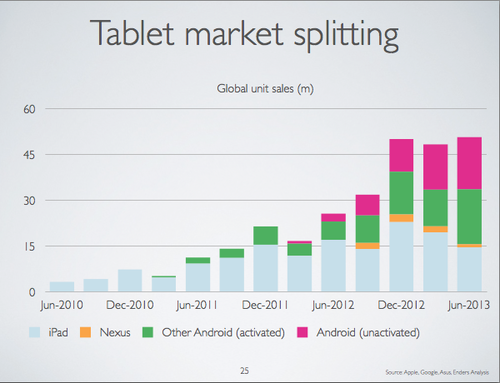What Are People Doing On All Those Cheap Tablets?
This is Fred Wilson’s question, but I’m repeating it because it’s an interesting one, and because I think I have answers beyond glorified remote controls and recipe books.
Like Fred I was also intrigued by Ben Evan’s post ‘iPads, price and self-selection‘. Also in common with Fred I really like the Nexus 7 – both new and old[1]. I bought a bunch of last year’s model for various family members, and recently got a 2013 LTE one for myself.

Here’s what I see the Nexus 7s that I bought for other people being used for:
- Kindle
- Gmail
- Some very light browsing
- Games when the kids get hold of them
Superficially that looks like a similar list to my own use:
- Feed.ly
- Gmail
- Casual gaming
- Browsing
- Watching videos
- Kindle
Looking at the lists one might argue that the tablets are used for much the same things, but if you were watching over our shoulders things would be very different.
I use my Nexus 7 online for hours every day – it’s a great device for curation [2] – a device for the 10% [3]. The digital footprints that I’m leaving with it will be at least as large as those I previously left with my iPad. I watch videos when I’m travelling, and I read books on Kindle when I’ve exhausted myself of online content, or just want to disconnect for a while.
My wife uses her Nexus 7 mostly for Kindle. Her digital footprints from it are likely very shallow. The other Nexus 7s in the family get used even less, their digital footprints are virtually non existent.
I think this explains the massive disparity between Android tablet sales, and Android’s share of page impressions across the web. People who’ve been buying Android tablets don’t use them online as much as iPad users, even the relatively high end ones like the Nexus 7.

I think cost comes into play a little here – if you’re using a tool a lot then you’ll buy a good tool. I happen to think that a 2013 Nexus 7 LTE is just as good (perhaps even better) for my own use cases than the equivalent iPad mini, so the price delta (which is almost all margin to Apple) isn’t justified for me. So Ben’s right in part – premium buyers self select in (even if the premium may no longer be deserved or necessary [4]).
There is however something else going on here. If the iPad is a device for the 10%, and cheap Android tablets are a device for the 90% then there’s a very skewed distribution of online engagement. The 90% don’t just consume – they consume a lot less than those who curate, and they in turn consume a lot less than those who create.
So the short answer to ‘What Are People Doing On All Those Cheap Tablets?’ feels to me like ‘very little – certainly a lot less than what you’re doing with your iPad’.
Notes:
[1] I’ve heard from some friends that they tried the original Nexus 7 and didn’t get on with it. My own (somewhat superficial) experiences were all good, but I didn’t have my own and work it hard. I’ve since read that there was a problem with the storage early on (since corrected) that caused major performance issues for heavy users. There were also reports of WiFi issues. To those who were put off I’d say try again (after updating to latest firmware etc.) and certainly give the 2013 model a go.
[2] It was Fred that brought my attention to the 90/9/1 rule ‘Out of 100 people, 1% will create the content, 10% will curate the content, and the other 90% will simply consume it.’
[3] I’m writing this post on my laptop rather than a tablet because even with Swype, speech recognition or a bluetooth keyboard tablets are *much* less effective for creative work.
[4] Though the Nexus 7 is still a premium device. The $349 I paid may be less than $629 for an equivalent iPad Mini, but it’s still a whole lot more than the cheap devices that are now knocking around.
Filed under: technology | 2 Comments
Tags: android, demographics, iPad, tablet
2 Responses to “What Are People Doing On All Those Cheap Tablets?”